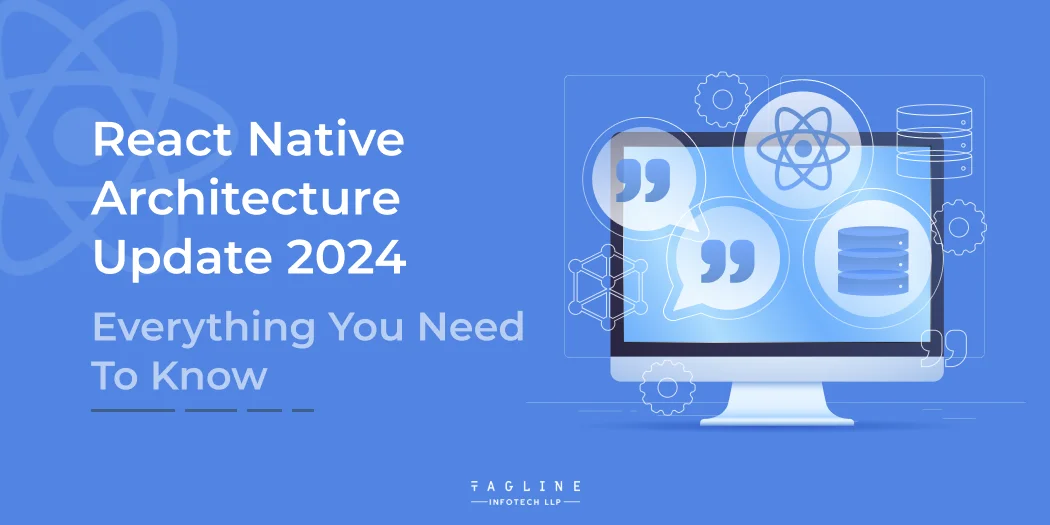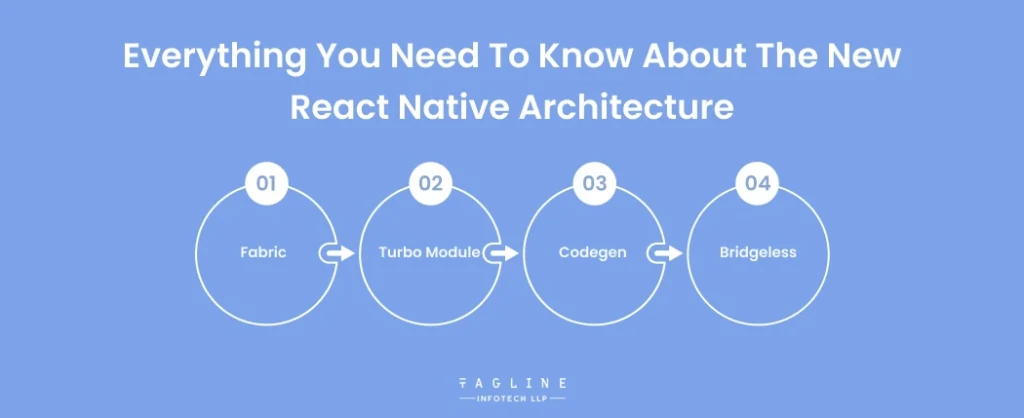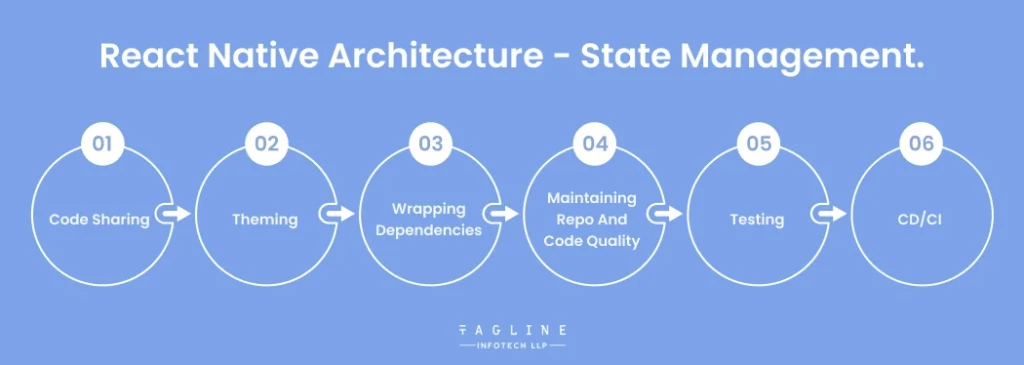What is the best way to format Python...
July 3, 2025
Home >> React Native >> React Native Architecture Update 2024: Everything You Need To Know

Before starting with the new React Native architecture, we must comprehend the operation of the current react native app architecture. React Native is a single-threaded framework, as is well known. Its three main threads—the main thread, the shadow thread, and the Javascript thread—are examples of React Native threads that don’t communicate directly with one another. Instead, asynchronous JSON threads connected by the Bridge are the primary means of communication between them. Since the Bridge is now an essential component of thread-to-thread communication in React Native, this connectedness results in dependency, uncertainty, and latency. React Native’s new architecture was necessary to meet the requirements because of this reliance.

The term “Fabric” is misleading because it’s usually used to describe the entire React Native new architecture instead of just the architecture itself. Unlike commonly believed, Fabric only shows the user interface layer, one layer of the total system.
Initially, Fabric architecture React Native allowed the generalisation of Shadow trees natively in C++ with the help of UIManager. Because there was no longer a need to flip between threads, this increased the degree of user interface involvement.
Additionally, Fabric exposes the user interface functions to the Javascript side by utilizing the JavaScript Interface (JSI). As a result, instead of interacting with the Javascript side via the Bridge, there is direct interaction from both ends. The JavaScript side can complete Time-sensitive user interface tasks to prioritize them and meet them simultaneously before any other charges. This control, the centre of attention, is the UI element that initiates priority queues.
Turbomodules are similar to Native modules in their most basic form but are implemented and behave differently.
The most beneficial feature of these modules is their slow loading speed for Turbomodules. Stated differently, the JavaScript code will maintain an explicit reference to each module and load them only when necessary. This could significantly reduce the startup time of applications, especially those with a high concentration of Native modules.
Another feature of the new React design that is meant to be helpful is codegen. The RN software will automatically check whether the Javascript and Native threads are synchronized and compatible. Furthermore, more native code will be generated during the build time rather than the run time.
The organization specifies that the interface elements that Turbomodules and Fabric use will be Codegen. All of this is done to eliminate the need for duplicate code and enable data transfer that is both faster and error-free. This is because data validation is no longer required at every iteration.
We are left wondering what happened to the Bridge now that we have a rudimentary understanding of the new architecture React Native. The redesign of the JavaScript Interface (JSI) component is one of the main objectives of the new architecture, which is to replace the bridge eventually. One of the main features of the new architecture is this.
It should be clear why the Bridge is being removed entirely from the new architecture React Native. Still, the main reasons are that it created unnecessary issues, raised doubts about whether data was received, and resulted in lengthy delays.
This layer is called the React Native JSI (Javascript interface), and it will replace the Bridge. The main goal is to remove the need for the Bridge to function as a middleman to enable communication between the Native and Javascript sides.
“What are React Native Elements and How to Install Them? “
– Also Read Article

State management is one of the most contentious issues in the JavaScript (JS) community today, and we are seeing a rise in the number of solutions that try to address it. It is essential for applications, especially those that are medium- to large-scale.
The requirements and the team’s experience level are the main things to consider when deciding which solution is best. An ecosystem built around a library, the expertise of developers, or community adoption and support are a few significant factors that can be considered throughout the selection process.
Redux has been a feature of the state management system for a while and has attracted much interest. Recent developments in both platforms have greatly expanded the power of RTK Query and Redux ToolKit. Another excellent option to consider is React Query, which is more API-centric. More and more products are becoming popular; Recoil, MobX, and others better fit your needs than anything else.
The most beneficial feature of React is its ability to translate concepts and ideas across different platforms. “Learn once, write everywhere” is a more relevant proverb now than in the past. Teams can share a large code base across several platforms, such as the web, virtual reality, and other media, once the foundations of React Native applications are correctly built. Teams can also use git submodules to distribute logic and components over many repositories.
Two libraries that are assisting in paving the way for the total portability of the code base between web and mobile platforms are Exposition and React Native Web. The most straightforward strategy to minimize costs for small- to medium-sized apps is to do this.
It is common knowledge that state-of-the-art front-end architectures can be produced from outstanding design. Robust architecture can be significantly enhanced using design languages and more sophisticated techniques such as micro-frontends and monorepos.
A robust design system sets the tone for your teams regarding design and development. When components are used consistently across different app portions, developers can create more robust application programming interfaces (APIs) for each element. This improves the components’ usability and prevents further technical debt from building up.
Large-scale React Native applications rely on many third-party libraries to help them function more quickly. However, time can also bring about a situation where a third-party library stops serving its purpose as it did when we first started using it, or a better solution could emerge.
In situations such as these, transferring libraries can prove to be a costly move. This modification can significantly affect our program if many modules use the problematic library extensively. Any such libraries should generally be wrapped with your application programming interface (API), and you should use them to package your software. This can come in rather handy if you decide to go to a different third-party library.
Remember that too much abstraction might make your code appear less aesthetically pleasing, so be careful and wise when adding stereotypes of this type. Moreover, platform-dependent libraries might customise their application programming interfaces (APIs) to ensure platform portability.
The larger the software, the more expensive it is to execute tests in an application. Therefore, it is wise to prepare beforehand to save time and ensure that our code is free of common errors like typos.
We can help ourselves avoid fundamental issues that could use up many of our continuous integration resources by implementing static typing and linting. One can run various tasks on a developer’s desktop when they commit code to the repository, including spell checking, linting, static type checking, and package audits. Git hooks can also be used to assist in maintaining the code quality across a large codebase with numerous contributors.
In the current climate, moving swiftly and breaking objects is no longer appropriate for React Native mobile app architecture. The standards and expectations that are being established are getting more intense by the day. Automated testing is the most crucial step for ongoing success in rapidly creating mobile applications.
According to recent remarks by a specialist who has worked in software development for the past thirty years, testing remains the most challenging step. Technologies are available that can make taking an exam enjoyable for the individual.
Create Business Application that truly impresses your users?
Our React Native developers skillfully utilize the latest architecture patterns, enabling rapid development to seamlessly align with your objectives.
Being able to react swiftly is more than just a competitive advantage in today’s market; firms must survive. You will be able to ship your apps with total confidence and peace of mind thanks to CI/CD. CI/CD can significantly speed up development and delivery if appropriately implemented.
If you are interested in using continuous integration and continuous delivery (CI/CD) for React Native programs, we have put together excellent resources that will help you build the best possible applications.
As mentioned, moving swiftly is crucial in the modern environment. It can be challenging, and faster iterations can lead to problems, even with a robust test suite, continuous integration, and continuous delivery. Firebase Software Development Kit (SDK) has crashlytics and performance monitoring features that you can use to log issues and monitor your application’s performance while it’s being used.
One of app developers’ most significant challenges is persuading users to update to newer software versions. Businesses have less control over the performance of an app that users are using than they have with web apps. Libraries and methods are now available for users of the iOS and Android platforms to alert them whenever a new version of the program is ready. For iOS and Android, in-app updates are wrapped by an open-source package called React Native In-App Update.
This might be helpful for several purposes, but more is needed. React Native new updates make it easier for applications to be updated over the air, as JavaScript houses most of the business and UI functionality found in React Native applications. Thanks to Microsoft CodePush, we can update the JS bundle of React Native applications without bothering our users.
Development teams make up the basis of every business that relies on technology. Those in charge of its development must have the best experience possible to deliver the best possible user experience. Those with the right development tools and approaches are more productive and dedicated.
Creating utility libraries, unit test cases, skeletal code, and testing are repetitive tasks that developers might automate to save time for more valuable work. Using AI’s assistance, teams can also accelerate their rate of development.
The features are affordable to get with the correct design. Nevertheless, this tactic is nonetheless effective despite its challenges. As a leading React Native Development Company, Establishing robust foundations in the initial stages of development is crucial for ensuring the scalability, reliability, and overall quality of your code base. Any errors made during this phase may lead to significant technical debt down the line.
One of the main strengths of the latest React Native architecture is that it provides the latest functionalities like code reusability, hot & live reload, pre-built components, and many more to ease the development process.
React Native is still going to be in demand in the future because its ability to handle Virtual DOM and easy integration of various libraries make it a preferable choice among developers.

Digital Valley, 423, Apple Square, beside Lajamni Chowk, Mota Varachha, Surat, Gujarat 394101
D-401, titanium city center, 100 feet anand nagar road, Ahmedabad-380015
+91 9913 808 2851133 Sampley Ln Leander, Texas, 78641
52 Godalming Avenue, wallington, London - SM6 8NW